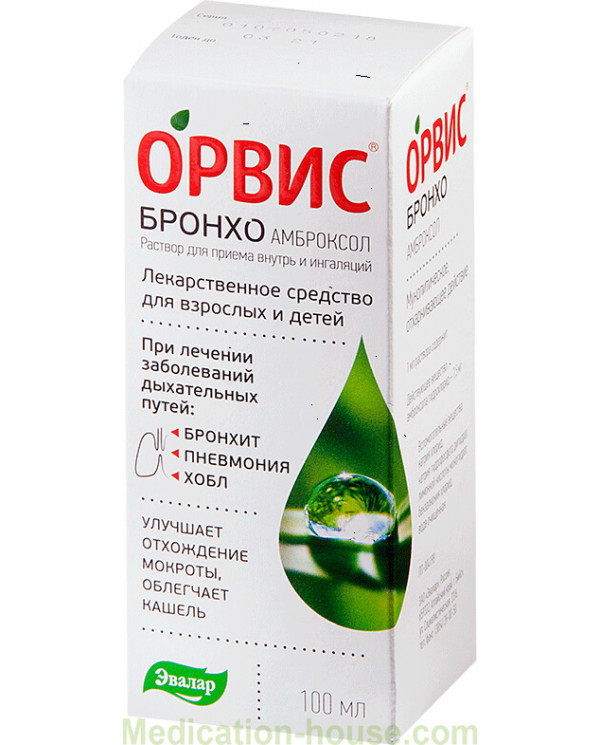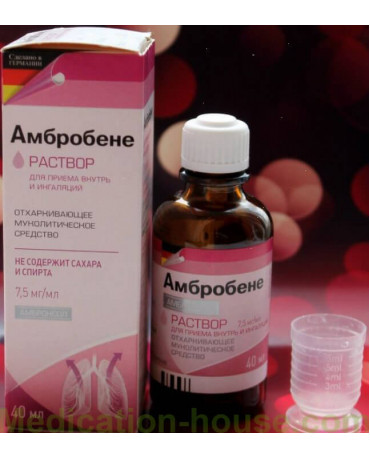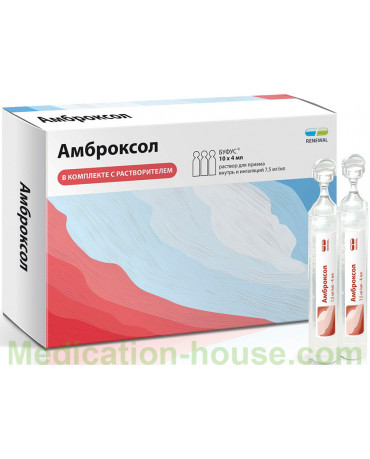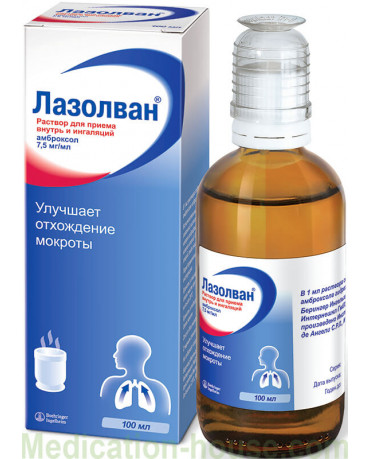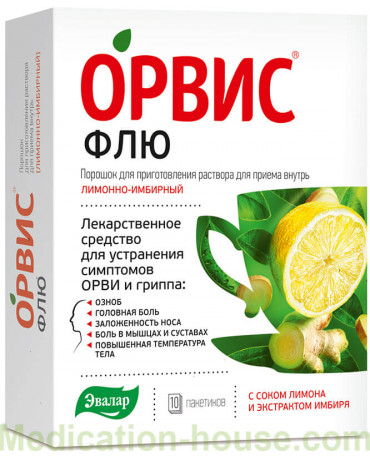Orvis Broncho Ambroxol instruction
You can buy Orvis Broncho Ambroxol here
Orvis Broncho Ambroxol Evalar is a mucolytic and expectorant drug.
Release form and composition
Dosage form - a solution for oral administration and inhalation: from colorless to brownish, transparent, has a slight characteristic odor (in a cardboard pack 1 glass bottle of 50 or 100 ml with / without a measuring cup in the kit and instructions for use by Orvis Broncho).
Composition of 1 ml of solution:
active substance: ambroxol hydrochloride - 7.5 mg;
auxiliary components: sodium hydrogen phosphate dihydrate - 4.35 mg; citric acid monohydrate - 2 mg; sodium chloride - 6.22 mg; benzalkonium chloride - 0.225 mg; purified water - 989,705 mg.
Pharmacodynamics
The active substance of Orvis Broncho - Ambroxol - is an active N-demethylated metabolite of bromhexine. It has a secretomotor, secretolytic and expectorant effect. Thanks to its use, the work of the bronchial glands is stimulated, the motor activity of the ciliated epithelium increases, which is ensured by the effect on the pneumocytes of the second type and Clara cells (in the alveoli and bronchioles, respectively). An increase in the formation of endogenous surfactant, a surfactant that provides glide in the lumen of the respiratory tract of bronchial secretion, is also noted.
Ambroxol contributes to an increase in the share of the serous component in bronchial secretion, this leads to an improvement in its structure, a decrease in viscosity and, as a result, liquefaction of sputum. The combination of these effects is manifested by an improvement in mucociliary transport (mucociliary clearance). Due to the increased mucociliary clearance, an improvement in the excretion of sputum from the bronchial tree and an improvement in cough are observed.
When taking Orvis Broncho inside, the therapeutic effect develops on average after 30 minutes, the duration of the effect depends on the dose and is in the range from 6 to 12 hours.
Pharmacokinetics
After oral administration, Ambroxol is rapidly and almost completely absorbed from the gastrointestinal tract. Cmax (maximum concentration of a substance) in blood plasma is achieved in 1-3 hours. The value of Vd (distribution volume) is 552 liters. Binding to plasma proteins in the therapeutic range of concentrations - from 80 to 90%.
The highest concentrations of ambroxol are recorded in the lungs. The substance crosses the blood-brain and placental barriers, excreted in breast milk. About 30% of an oral dose of ambroxol is exposed to the effect of the initial passage through the liver.
According to studies on human liver microsomes, the dominant isoform, which is responsible for the metabolism of ambroxol to dibromanthranilic acid, is the CYP3A4 isoenzyme. The remainder of the substance is metabolized in the liver by conjugation with the formation of metabolites that do not have pharmacological activity.
Terminal T1 / 2 (elimination half-life) of a substance from blood plasma - 10 hours. The total T1 / 2 value of Ambroxol and its metabolites is approximately 22 hours. Excretion is carried out by the kidneys: in the form of metabolites - 90% of the dose, unchanged - 10%.
No clinically significant effect of the patient’s gender and age on the pharmacokinetic parameters of ambroxol was found, so there is no reason for dose adjustment.
Indications for use
Orvis Broncho is prescribed for the treatment of acute and chronic respiratory tract diseases with the release of viscous sputum:
bronchial asthma with difficulty in sputum discharge;
chronic obstructive pulmonary disease;
bronchiectatic disease;
acute and chronic bronchitis;
pneumonia.
Contraindications
Absolute:
I trimester of pregnancy and lactation;
individual intolerance to the components of the drug.
Relative (Orvis Broncho is appointed under medical supervision):
severe liver failure;
renal failure;
exacerbation of peptic ulcer of the stomach and duodenum;
impaired motility of the bronchi and increased secretion of mucus (in patients with fixed cilia syndrome);
II – III trimester of pregnancy.
Orvis Broncho, instructions for use: method and dosage
1 ml of Orvis Broncho corresponds to 25 drops.
Oral administration
The solution should be taken after meals, adding it to water, tea, fruit juice or milk.
Recommended dosage:
adults and children from 12 years old: 3 times a day, 4 ml each, after 2-3 days, the frequency of administration is reduced to 2 times a day; maximum - 90 mg per day;
children 6-12 years old: 2-3 times a day, 2 ml each; maximum - 45 mg per day;
children 2-6 years: 3 times a day, 1 ml; maximum - 22.5 mg per day;
children under 2 years: 2 ml per day, 1 ml (under medical supervision); maximum - 15 mg per day.
To enhance the mucolytic effect of Orvis Broncho during the period of therapy, you need to use a lot of fluids.
Inhalation
Recommended dosage:
adults and children from 6 years of age: 1-2 inhalations of 2-3 ml of solution per day;
children under 6 years: 1-2 inhalations of 2 ml of solution per day.
Orvis Broncho can be used using any modern equipment for inhalation (with the exception of steam inhalers).
In order to achieve optimal hydration during inhalation, Orvis Broncho should be mixed with a 0.9% sodium chloride solution in a 1: 1 ratio.
A deep breath during inhalation therapy can provoke a cough, so inhalations should be carried out in the usual breathing mode. Before the procedure, it is recommended to heat the solution to body temperature.
In case of bronchial asthma, patients should be inhaled after applying bronchodilators, this will avoid non-specific irritation of the respiratory tract and their spasm.
If after 4–5 days of therapy the symptoms of the disease persist, it is necessary to consult a doctor.
Side effects
Possible adverse reactions (> 10% - very often;> 1% and <10% - often;> 0.1% and <1% - infrequently;> 0.01% and <0.1% - rarely; <0, 01% - very rarely; with an unknown frequency - there is no way to set the frequency of unwanted reactions):
immune system: rarely - angioedema, urticaria, skin rash, hypersensitivity reactions, itching; in isolated cases - anaphylactic reactions (including anaphylactic shock);
digestive system: often - nausea, decreased sensitivity in the pharynx or oral cavity; infrequently - abdominal pain, dyspepsia, diarrhea, vomiting; rarely - dryness of the mucous membrane of the pharynx and oral cavity; with an unknown frequency - constipation, heartburn;
nervous system: often - dysgeusia;
respiratory system: rarely - rhinorrhea, dry mucous membrane of the respiratory tract;
skin and subcutaneous tissue: very rarely - Stevens-Johnson syndrome, toxic epidermal necrolysis (Lyell syndrome);
other: with an unknown frequency - fever, adynamia.
Overdose
In humans, the specific symptoms of an overdose of ambroxol are not described.
The main symptoms: vomiting, nausea, diarrhea, abdominal pain, dyspepsia (correspond to the known adverse reactions of Ambroxol, which is used in recommended doses).
Therapy: in the first 1-2 hours after taking Orvis Broncho, artificial vomiting, gastric lavage is effective, further intake of fat-containing products and symptomatic treatment are indicated.
special instructions
The combined use of Orvis Broncho with antitussive agents, in which there is difficulty in eliminating sputum, is not recommended.
In order to maintain a secretolytic effect during the period of therapy with Orvis Broncho, it is necessary to ensure the flow of a sufficient amount of fluid into the body.
Ambroxol on the background of bronchial asthma can lead to increased coughing.
1 ml of Orvis Broncho contains 10 mg of sodium, which should be taken into account in patients who follow a hyponatrium diet.
The composition of the drug as a preservative includes benzalkonium chloride, which in sensitive patients with increased reactivity of the respiratory tract during inhalation can lead to bronchospasm.
Mix Orvis Broncho with alkaline solutions and cromoglicic acid is not recommended.
Patients with severe renal failure (with creatinine clearance less than 30 ml / min) should consider the probability of cumulation of ambroxol metabolites.
There is information about isolated cases of development during the treatment with Ambroxol of Stevens-Johnson syndrome and Lyell's syndrome. The causal relationship between these phenomena has not been confirmed. Most often, these disorders could be explained by the severity of the underlying disease and / or concomitant treatment.
Against the background of Stevens-Johnson syndrome or Lyell's syndrome in the early phase, the development of symptoms such as fever, rhinitis, pain in the body and throat, cough is possible. When carrying out symptomatic treatment, erroneous administration of drugs with a mucolytic effect is possible, including ambroxol. With the development of these syndromes, it is recommended that you stop using Orvis Broncho and immediately seek medical help.
Pregnancy and lactation
I trimester of pregnancy and lactation: the use of Orvis Broncho is contraindicated;
II – III trimesters of pregnancy: therapy can be carried out only after assessing the ratio of expected benefits and possible risks.
With impaired renal function
Against the background of renal failure, therapy should be carried out with caution.
With impaired liver function
Orvis Broncho for severe liver failure should be used with caution.
Drug interaction
Possible interactions:
drugs with an antitussive effect: sputum discharge is difficult, which is associated with the suppression of the cough reflex;
amoxicillin, cefuroxime, doxycycline, erythromycin: the concentration of these drugs in bronchial secretion increases.
Terms and conditions of storage
Store at temperatures up to 25 ° C. Keep out of the reach of children.
Shelf life is 3 years.
Reviews
Reviews about Orvis Broncho are mostly positive. It is noted that against the background of therapy, sputum begins to recede faster, which accelerates recovery. Cost is estimated as affordable.
Terms of sell
You don't need a prescription to buy Orvis Broncho.

